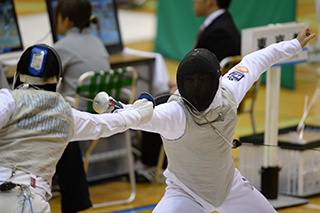Fencing
[Competition venue: Makuhari Messe Hall B]
-

Overview
Strip (playing area) : 1.5 m ~ 2.0 m wide x 14 m long (conductive panel)Individual: Nine minutes (three minutes x three periods, with a one-minute break between periods);
15 hits (the first fencer to score 15 points is the winner)Team (four members per team): Round-robin relay among three fencers on each team;
A set of nine three-minute periods (each period finishes when one fencer scores five hits), and the first team to score 45 points wins the bout (or score more points than the opponent in the nine periods).Events : foil, épée and sabre events
(Valid target areas differ according to the event)Key Points
Chivalry, elegant performance, psychological tactics, speedy passages of play, and scientific techniques are among the attractions of fencing.
History
Fencing developed with the aim of protecting one's life and honour during Europe's Middle Ages, when the concept of chivalry was at its height. In later centuries, its practical use as a battlefield weapon declined with the advent of firearms. However, swordsmanship skills continued to draw admiration and fencing gradually developed into a sport. In 1750, the wire mesh fencing mask was invented. The mask dramatically reduced the danger of fatal and facial injury, and fencing competitions grew in popularity throughout Europe.
Fencing has been contested as part of the official Olympic programme since the Athens 1896 Olympic Games.
Initially, there were no uniform competition rules, resulting in many problems. However, after uniform rules were established at the IOC Congress in 1914, competition fairness has been guaranteed, and disputes over judging decisions are now extremely rare. These uniform rules became the basis for the Rules for Competitions of the Federation Internationale d'Escrime (FIE).
Electronic scoring was first introduced for the épée events in 1936, further reducing human error in judging. Electronic scoring was eventually introduced for all fencing events and is now the accepted as the fairest form of point scoring.Detail
Men Women Event Individual Foil
Individual Epée
Individual Sabre
Team Sabre
Team Foil
Team EpéeIndividual Foil
Individual Epée
Individual Sabre
Team Sabre
Team Foil
Team Epée
(Updated on April 10, 2019)

